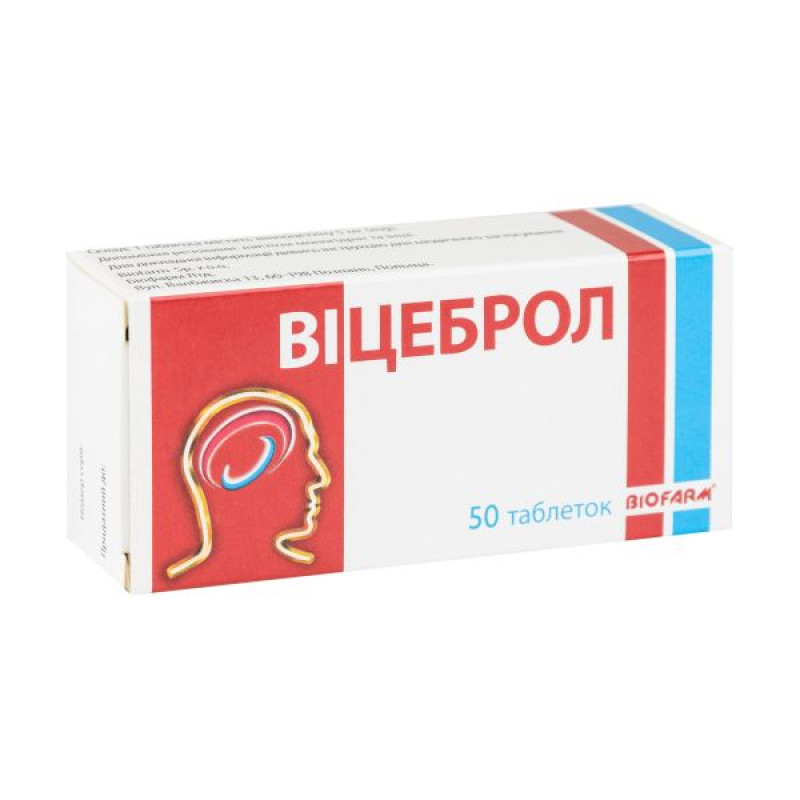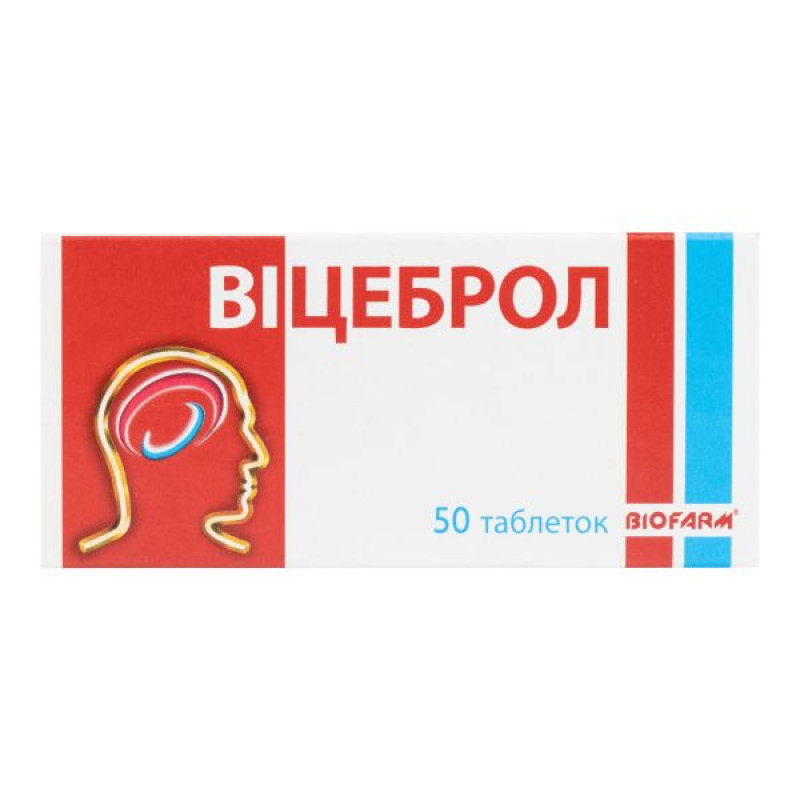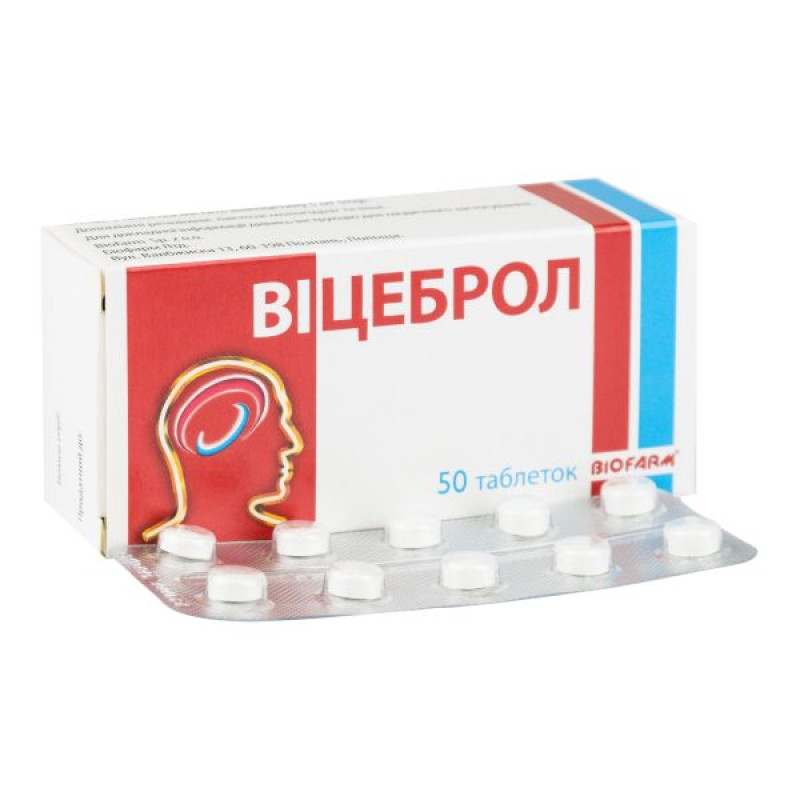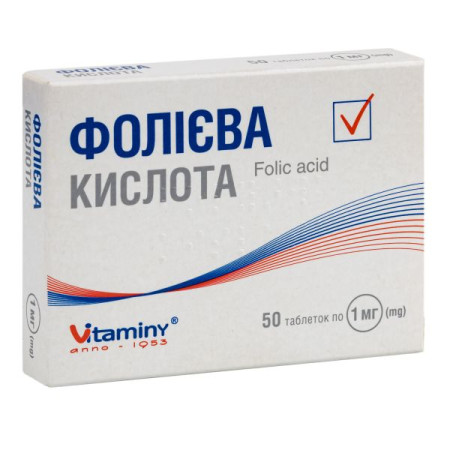Vicebrol tablets 5 mg blister No. 50

Instructions for use Vicebrol tablets 5 mg blister No. 50
Composition
active ingredient: vinpocetine;
1 tablet contains vinpocetine 5 mg;
Excipients: lactose monohydrate, microcrystalline cellulose, pregelatinized starch, magnesium stearate.
Dosage form
Pills.
Main physicochemical properties: round biconvex tablets of white color.
Pharmacotherapeutic group
Psychostimulants and nootropics. ATX code N06B X18.
Pharmacological properties
Pharmacodynamics
Vinpocetine is a compound with a complex mechanism of action that has a beneficial effect on metabolism in the brain and improves its blood supply, as well as improves the rheological properties of blood.
Vinpocetine exhibits neuroprotective effects: the drug attenuates the harmful effects of cytotoxic reactions caused by stimulating amino acids. The drug inhibits voltage-gated Na+ and Ca2+ channels, as well as NMDA and AMPA receptors. The drug enhances the neuroprotective effect of adenosine.
Vinpocetine stimulates cerebral metabolism: the drug increases the uptake of glucose and oxygen and the consumption of these substances by brain tissue. The drug increases the brain's resistance to hypoxia; increases the transport of glucose - the exclusive source of energy for the brain - through the blood-brain barrier; shifts glucose metabolism towards the more energetically favorable aerobic pathway; selectively inhibits the Ca2+-calmodulin-dependent enzyme cGMP-phosphodiesterase (PDE); increases the level of cAMP and cGMP in the brain. The drug increases the concentration of ATP and the ATP/AMP ratio; enhances the metabolism of noradrenaline and serotonin in the brain; stimulates the ascending noradrenergic system; has antioxidant activity; as a result of all the above effects, vinpocetine has a cerebroprotective effect.
Vinpocetine improves microcirculation in the brain: the drug inhibits platelet aggregation, reduces pathologically increased blood viscosity, increases erythrocyte deformability and inhibits adenosine uptake, improves oxygen transport in tissues by reducing the affinity of oxygen for erythrocytes.
Vinpocetine selectively increases blood flow in the brain: the drug increases the cerebral fraction of cardiac output; reduces vascular resistance in the brain without affecting the parameters of systemic circulation (blood pressure, cardiac output, pulse rate, total peripheral resistance); the drug does not cause a "stealing effect". Moreover, against the background of the drug, blood flow to damaged (but not yet necrotic) areas of ischemia with low perfusion ("reverse steal effect") improves.
Pharmacokinetics
Absorption. Vinpocetine is rapidly absorbed, with peak plasma concentrations occurring 1 hour after oral administration. The primary site of absorption of vinpocetine is the proximal gastrointestinal tract. The compound is not metabolized during passage through the intestinal wall.
Distribution. In oral studies in rats, radiolabeled vinpocetine was found in the liver and gastrointestinal tract in the highest concentrations. Maximum tissue concentrations were detected 2-4 hours after administration. The concentration of radioactivity in the brain did not exceed the concentration in the blood.
In humans: binding to blood proteins is 66%. Absolute bioavailability of vinpocetine when administered orally is 7%. Volume of distribution is 246.7±88.5 l, which indicates a pronounced binding of the substance in the tissues. The value of vinpocetine clearance (66.7 l/h) in blood plasma exceeds its value in the liver (50 l/h), which indicates extrahepatic metabolism of the compound.
Metabolism. The main metabolite of vinpocetine is apovincamic acid (AVC), which is formed in humans in 25-30%. After oral administration, the area under the AVC concentration-time curve is 2 times higher than after intravenous administration of the drug, indicating the formation of AVC in the process of presystemic metabolism of vinpocetine. Other metabolites identified are hydroxyvinpocetine, hydroxy-AVC, dihydroxy-AVC-glycinate and their conjugates with glucuronides and/or sulfates. In each of the studied species, the amount of vinpocetine excreted unchanged was only a few percent of the dose of the drug.
Excretion. With repeated oral administration of the drug at a dose of 5 mg and 10 mg, vinpocetine exhibits linear kinetics; equilibrium concentrations in blood plasma are 1.2 ± 0.27 ng / ml and 2.1 ± 0.33 ng / ml, respectively. The half-life in humans is 4.83 ± 1.29 hours. In studies conducted using a radiolabeled compound, it was found that the main route of excretion is through the kidneys and intestines in a ratio of 60:40%. A large amount of radioactive label in rats and dogs was detected in the bile, but no significant enterohepatic circulation was noted. Apovincamic acid is excreted through the kidneys by simple glomerular filtration, the half-life of this substance varies depending on the dose and route of administration of vinpocetine.
Changes in pharmacokinetic properties in special circumstances (for example, at a certain age, in the presence of concomitant diseases). Since vinpocetine is indicated for the treatment of mainly elderly patients, in whom changes in the kinetics of drugs are observed - reduced absorption, different distribution and metabolism, reduced excretion - it was necessary to conduct a study to assess the kinetics of the drug in this age group, especially with long-term use. The results of such studies have shown that the kinetics of vinpocetine in elderly people do not differ significantly from the kinetics of vinpocetine in young people, and, in addition, there is no cumulation. In case of impaired liver or kidney function, normal doses of the drug can be used, since vinpocetine does not accumulate in the body of such patients, which allows taking the drug for a long time.
Indication
Neurology. For the treatment of various forms of cerebrovascular pathology: conditions after a stroke, vertebrobasilar insufficiency, vascular dementia, cerebral atherosclerosis, post-traumatic and hypertensive encephalopathy. Helps reduce mental and neurological symptoms in cerebrovascular pathology.
Ophthalmology. For the treatment of chronic vascular pathology of the choroid (the vascular membrane of the eye) and retina.
Otorhinolaryngology. For the treatment of senile perceptual hearing loss, Meniere's disease, and tinnitus.
Contraindication
Hypersensitivity to the active substance or to any of the excipients.
Pregnancy, breastfeeding period.
The use of the drug in children is contraindicated (due to the lack of data from relevant clinical studies).
Interaction with other medicinal products and other types of interactions
The simultaneous use of vinpocetine with β-blockers (cloranolol, pindolol), clopamide, glibenclamide, digoxin, acenocoumarol or hydrochlorothiazide in clinical studies was not accompanied by any interaction between them.
The simultaneous use of vinpocetine and α-methyldopa sometimes caused some increase in the hypotensive effect, therefore, regular monitoring of blood pressure is necessary when using this combination of drugs. Despite the lack of clinical data confirming the possibility of interaction, caution is recommended when prescribing vinpocetine with drugs that affect the central nervous system, as well as in the case of concomitant antiarrhythmic and anticoagulant therapy.
Application features
The presence of long QT syndrome and the use of drugs that cause QT prolongation require periodic ECG monitoring.
If the patient has increased intracranial pressure, arrhythmia or long QT syndrome, as well as against the background of the use of antiarrhythmic drugs, a course of therapy with the drug can be started only after a thorough analysis of the benefits and risks associated with the use of the drug.
This medicinal product contains lactose monohydrate. Patients with rare hereditary problems of galactose intolerance, the Lapp lactase deficiency or glucose-galactose malabsorption should not take this medicinal product.
Use during pregnancy or breastfeeding
The use of the drug during pregnancy or breastfeeding is contraindicated.
Pregnancy. Vinpocetine crosses the placental barrier, with drug concentrations in the placenta and fetal blood being lower than in the blood of the pregnant woman. No teratogenic effects have been identified. In preclinical studies with high doses of the drug, placental bleeding and spontaneous abortion occurred in some cases, probably as a result of increased placental blood supply.
Breastfeeding. Vinpocetine passes into breast milk. In studies using a radioactive isotope, the radioactivity of breast milk was 10 times higher than that in the blood of an adult animal. The use of vinpocetine during breastfeeding is contraindicated due to the penetration of vinpocetine into breast milk and the lack of sufficient clinical observations on the safety of the drug for infants. After taking a single dose of vinpocetine, 0.25% of the dose of the drug passes into breast milk within an hour.
Ability to influence reaction speed when driving vehicles or other mechanisms
There is no data on the effect of vinpocetine on the ability to drive or operate machinery, but caution should be exercised, given the possibility of drowsiness and dizziness when using the drug.
Method of administration and doses
Take orally after meals. The daily dose for adults is 15-30 mg (3 times a day, 5-10 mg). The duration of treatment is determined by the doctor individually.
Patients with kidney or liver disease do not require dosage adjustment.
Children
The drug is not used in children (due to the lack of clinical data).
Overdose
Symptoms of overdose are unknown. According to the literature, a dose of 60 mg/day is safe. A single dose of 360 mg of vinpocetine was not accompanied by the development of either cardiovascular or other side effects.
Adverse reactions
From the blood and lymphatic system: leukopenia, thrombocytopenia, anemia, erythrocyte agglutination.
Immune system disorders: hypersensitivity.
Metabolic: hypercholesterolemia, decreased appetite, anorexia, diabetes mellitus.
On the part of the psyche: insomnia, sleep disorders, anxiety, excitement, euphoria, depression.
From the nervous system: headache, dizziness, dysgeusia, stupor, hemiparesis, drowsiness, amnesia, tremor, convulsions.
On the part of the organs of vision: swelling of the optic nerve head, conjunctival hyperemia.
From the side of the organs of hearing and labyrinth: vertigo, hyperacusis, hypoacusis, tinnitus.
Cardiovascular system: myocardial ischemia/infarction, angina pectoris, bradycardia, tachycardia, extrasystole, palpitations, arrhythmia, atrial fibrillation, hypotension, hypertension, hot flashes, thrombophlebitis, blood pressure fluctuations.
On the part of the digestive tract: abdominal discomfort, dry mouth, nausea, abdominal pain, constipation, diarrhea, dyspepsia, vomiting, dysphagia, stomatitis.
Skin and subcutaneous tissue disorders: erythema, hyperhidrosis, pruritus, urticaria, rash, dermatitis.
General disorders: asthenia, weakness, feeling hot, chest discomfort, hypothermia.
Laboratory indicators: decreased blood pressure, increased blood pressure, increased triglyceride levels in the blood, ST segment depression on the electrocardiogram, increased/decreased eosinophil count, changes in liver enzyme activity, increased/decreased leukocyte count, decreased erythrocyte count, decreased prothrombin time, increased body weight.
Expiration date
3 years.
Storage conditions
Store at a temperature not exceeding 25 ° C. Keep out of the reach of children.
Packaging
10 tablets in a blister; 5 blisters in a cardboard box.
Vacation category
According to the recipe.
Producer
Biopharm Ltd.
Location of the manufacturer and its business address
Walbrzyska Street 13, 60-198 Poznań, Poland.
There are no reviews for this product.
There are no reviews for this product, be the first to leave your review.
No questions about this product, be the first and ask your question.













